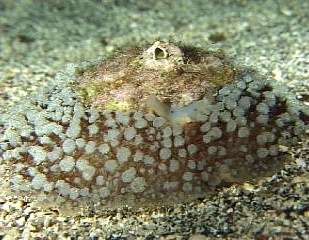
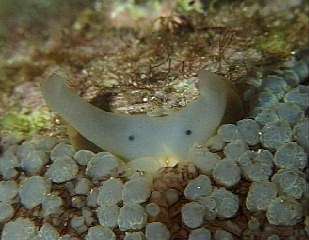
Umbraculum mediterraneum
(Lamarck, 1819)
Order: NOTASPIDEA
Superfamily: TYLODINOIDEA
Family: Umbraculidae
DISTRIBUTION
Mediterranean and east Atlantic (Madeira, Azores, Cape Verde, St Helena Is.) Also reports in Forum from Canary Ids and Florida.
PHOTO
El Hierro, Canary Islands.
PHOTOS: Mark Thorpe & Katja Nagengast, OCEAN-EYE VIDEO. ocean-eye-video@tenerife1.com.
The general feeling is that there is probably only one species of Umbraculum worldwide. If that is so the earliest name is Umbraculum umbraculum. However it is possible that the east Atlantic form could be distinguished as Umbraculum mediterraneum but I am not sure where that leaves animals from the west Atlantic. Despite a general trend to synonymise U. mediterraneum with U. umbraculum, no one has examined the anatomy of these two species to see if this is justified. Until someone does, I feel we might as well continue to differentiate the Atlantic and Indo-West Pacific populations with separate names. See continuing discussion in messages on both species pages. See photos below from Florida.
Reference:
• Lamarck, J.B.P.A. de M. (1819) Histoire naturelle des animaux sans vertebres, presentant les caracteres generaux et particuliers de ces animaux, leur distribution, leur classes, leurs familles, leurs genres, et al citation des principales especes qui s'y rapportent; precedee d'une Introduction offrant la determination des caracteres essentiels de l'Animal, sa distinction du vegetal et des autres corps naturels, enfin, l'Exposition des Principes fondamentaux de la Zoologie 6(1): i-vi, 1-343. Paris, Chez l'Auteur, au Jardin du Roi.
• Marcus, Ev. (1985) Catalogue of the western Atlantic warm water Opisthobranchia. 10. The western Atlantic warm water Notaspidea Gastropoda, Opisthobranchia), Part 3, Umbraculacea. Boletim de Zoologia, Universidade de Sao Paulo, 9: 1-15
• Vayssière, A (1885) Recherches zoologiques et anatomiques sur les mollusques Opisthobranches du Golfe de Marseille. Pt. 1, Tectibranches. Annales du Musee d'Histoire Naturelle de Marseille, Zoologie 2, Mem. 3: 1-181. (pls 1-6)
Rudman, W.B., 1999 (January 14) Umbraculum mediterraneum (Lamarck, 1819). [In] Sea Slug Forum. Australian Museum, Sydney. Available from http://www.seaslugforum.net/find/umbrmedi
Related messages
Umbraculum from Venezuela
August 5, 2006
From: Virginia Malpica

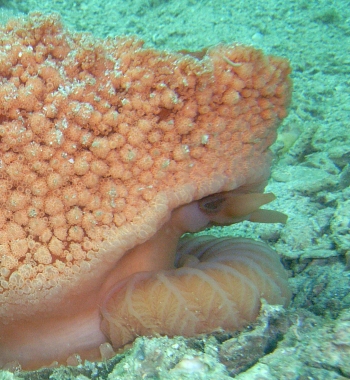
Hi,
I own the dive shop Aquatic Adventures, in Puerto La Cruz, Venezuela and do a lot of teaching and diving in Mochima National Park. The creature I saw at a dive site we go to often and it is the first time I have seen it, although since I took this picture the end of June, it was spotted at a nearby site about a week later in a coral reef at about 35 feet. I assume it is some kind of sea hare.
I saw it in 23 feet of water over a sandy spot in the reef, close to a large sandy area( I wonder if it wandered to the reef area from the sand?) It was alone and I went back twice the same week and couldn't find it. It was a very vivid orange and was squarish about 8 inches long by 4 inches high and 4 inches wide. I can't find it on any web site, any ideas? Another diver took pictures and I could send more if it would help identification. Gina Malpica
Locality: Chimanita Island, Chimana Islands, 23 feet, Puerto La Cruz, Venezuela, Caribbean Sea, Late June, early July,2006 , Sandy part of Coral Reef. Length: 8 inches long, 4 inches tall. Photographer: Virginia Malpica.
Virginia Malpica
icalfmalpica@cantv.net
Malpica, V. M., 2006 (Aug 5) Umbraculum from Venezuela. [Message in] Sea Slug Forum. Australian Museum, Sydney. Available from http://www.seaslugforum.net/find/17265
Dear Gina,
This is a photo of a rather sad looking Umbraculum. Why I say sad is because it is lying upside down, a bit like a stranded sea turtle. The 'top' in your photos is really the sole of its foot. Have a look at the Fact Sheets on Umbraculum mediterraneum and U. umbraculum for more information on this animal. Your photo does give us a good view of the large gill these animals have, which is usually hidden beneath their flattened shell. You would expect its mouth to be up on the 'head' between the two tentacles, but in Umbraculum it is down on the sole of the foot.
In your 'side on' photo, the brown patch behind the tentacle is a sensory pit which is used for sensing chemicals in the water.
Best wishes,
Bill Rudman
Umbraculum from Turkey
July 7, 2006
From: Charles McGurk
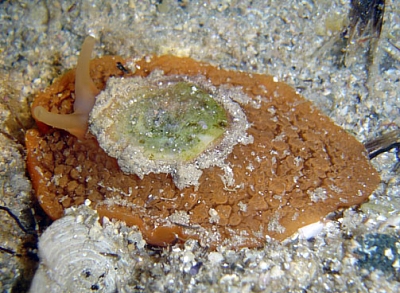
I'd be grateful if someone could please offer an opinion upon this specimen photographed near Bodrum in Turkey. I thought that it might be Dendrodoris limbata, although could not work out what the disc-shaped dorsal mass is. Could it be parasitic?
Locality: Bay, 3 m, Turkey, Aegean, 17 June 2006, Sheltered bay. Length: ~30 mm. Photographer: Charles McGurk.
Many thanks for any replies.
Charles McGurk
charles.mcgurk@mail.com
McGurk, C, 2006 (Jul 7) Umbraculum from Turkey. [Message in] Sea Slug Forum. Australian Museum, Sydney. Available from http://www.seaslugforum.net/find/16981Dear Charlie,
This is a primitive slug, Umbraculum mediterraneum. The disc-shaped mass on its back is its flattened shell - all that is left to remind us of its snail ancestry.
Best wishes,
Bill Rudman
Umbraculum mediterraneum from Croatia
May 16, 2006
From: Andrej Jaklin
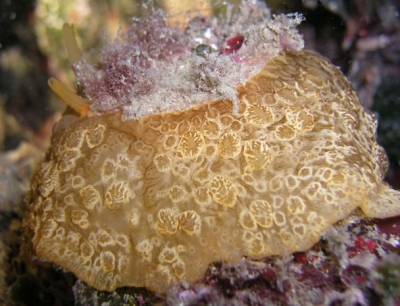
Dear Bill,
In the comment on how to (possibly) distinguish two species of Umbraculum (message #8411 ) you mentioned "whitish radial marks on the edge of the tubercles".
I think attached picture shows/confirms that very nicely.
Locality: Korcula Island, unknown, Croatia, Middle Adriatic Sea, 28 April 2004, night dive. Length: unknown. Photographer: Miljenko Marukic.
Best regards,
aj
jaklin@cim.irb.hr
Jaklin, A., 2006 (May 16) Umbraculum mediterraneum from Croatia. [Message in] Sea Slug Forum. Australian Museum, Sydney. Available from http://www.seaslugforum.net/find/16603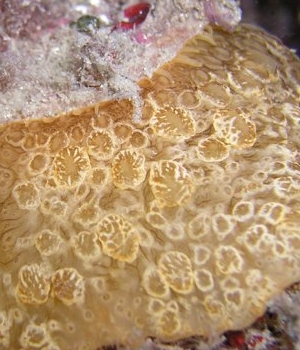
Dear Andrej,
It definitely does, but since then it has become clear that Indo-West Pacific animals [see message 12844] can also have this radiating pattern. I think it is caused by grooves around the tubercles which get deeper and shallower depending on the 'inflation' of the tubercles. I also suspect the whitish coloration to be glandular secretions - possibly defensive.
Best wishes,
Bill Rudman
Umbraculum mediterraneum
January 26, 2005
From: Luigi Montevecchi


Hi, Bill
There are two pictures of a big opisthobranch (Umbraculum mediterraneum), taken last summer in Italy. The second one is a close-up of its back. I appreciate your comments
Locality: Tremiti Islands - Caprara - Cala Caffè, Italy, Adriatic Sea
Depth: -27.7 m. Length: 80 mm approx. 17 August 2004
Rocky wall, sandy at the bottom (35 m). Photographer: Luigi Montevecchi
Thanks
Luigi
montevecchi@iol.it
Montevecchi,L, 2005 (Jan 26) Umbraculum mediterraneum . [Message in] Sea Slug Forum. Australian Museum, Sydney. Available from http://www.seaslugforum.net/find/12921Dear Luigi,
There is not much more I can say on this species than you will find in the accompanying messages. One surprising feature of your animal is the remarkably clean shell. Usually in this species the shell is covered with growths. There must be something about where it lives which makes it difficult for fouling plants and animals to settle out of the plankton
Best wishes,
Bill Rudman
Umbraculum f rom Florida
July 16, 2004
From: Robert Shearer
FYI,
Large Umbraculum sighting. Sorry, no picture. . .
LOCATION: off Boca Raton, Florida
LATITUDE: 26 19.281, LONGITUDE: 80 03.538
DATE: 9 May 2004, TIME: 10:30am
Found loose on sand in coral trail between the wreck of Sea Emperor and the United Caribbean.
It looked like a 9-10inch [25cm] diameter orange sphere, seemed uniform all around at first -- sort of like cauliflower head with similar surface shape (texture like the surface of a brain). It had a depression on the bottom without the warty surface. It had some white stringy, wispy material on the surface.
When I picked it up, it was not attached at all to the sand. It was soft and pliable (like soft foam they make some mattresses from) and the surface reshaped readily. On the top center was a flat oval-shaped 2x3"disk that seemed hard/calciferous. There was almost no growth on it and showed slight concenteric circles like growth lines on an operculum. When I pushed the body away from the disk slightly, you could see that it was attached by a 3/4" high, slightly converging structure, like a fat stalk. This was made up with a repeating pattern that looked like pieces cut from the middle part of feathers -- shaft with branching lines (gills). When you let the body go, the disk recessed until this attachment was again not visible, the disk flush with the surface of the body.
It didn't seem to have any internal shell or rigid structure that I could feel. Meanwhile, the depression on the bottom had opened out on my gloved hand and the body edging it had molded to the shape of my hand. I could pull my hand away fairly easily. The surface of this depression had a flatter, denser surface than the body with very small lobes compared to the body. I couldn't see anything of a "mouth" (as an anemone migh have). I fanned away some of the white material, but it seemed to reappear. The color seemed more pinkish as I brought it to the surface -- still uniform all over accept the disk that was grey-white. I carried it to the surface and had the DM put it in a bucket while I went back to finish the dive.
Unfortunately, no one took a picture of it and I felt compelled to let it go before leaving, so I don't have a specimen. I should have known better, but I thought I might be some sort of rare local critter, so didn't want to remove it.
ID confirmed by similar structured critters on the Forum [messages #2542 #7832]. However, this one was much larger. I do not know if this is really an exotic or rare species. I see that others have been photographed in the area.
Robert Shearer
Robert.Shearer@juno.com
Shearer, R., 2004 (Jul 16) Umbraculum f rom Florida. [Message in] Sea Slug Forum. Australian Museum, Sydney. Available from http://www.seaslugforum.net/find/12653Thanks Robert,
It certainly sounds like Umbraculum. We have no idea just how common these animals are. Their shape and appearance, and the growths that often grow on their external shell help to camouflage them from all but the most diligent searchers. There are also reports of them burying in shell sand, at least to shell level, which also means it will be difficult to get an accurate idea of their abundance.
Best wishes
Bill Rudman
Umbraculum mediterraneum from Cape Verde Ids
September 5, 2003
From: Gérard Breton
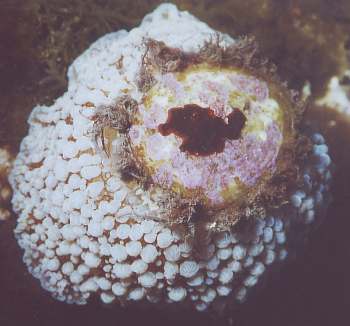
Dear Bill,
Here is a photo of Umbraculum mediterraneum I took while diving between the 22 - 30 March 2003 at Fogo Island in the Cape Verde Archipelago
Data: Salinas, Fogo Island - 3m. Resting in a natural harbour where seaweeds are abundant and diverse.
Best wishes.
Gérard Breton
Gerard.Breton@ville-lehavre.fr
Breton, G., 2003 (Sep 5) Umbraculum mediterraneum from Cape Verde Ids. [Message in] Sea Slug Forum. Australian Museum, Sydney. Available from http://www.seaslugforum.net/find/10737Thanks Gerard,
Bill Rudman
Re: Caribbean Umbraculum - mating
April 29, 2003
From: Dee Scarr
Hi Bill,
Don't I wish I could have been the intrepid naturalist who got the information on Umbraculum mating, but we just didn't feel comfortable being that intrusive ... I had to go off-island for a week immediately after that dive, and since my return I've only found one individual (last night, after several daytime searches), and no eggs. I'll be keeping alert, though.
It's interesting that I've only seen these critters feeding at night, but the mating was taking place in the daytime. Great photo of the egg laying!
I've only seen them eating one type of sponge, which I think is Holopsamma helwigi. Is the purpose of the pustules/warts known?
Sorry -- and thanks,
Dee Scarr
dee@touchthesea.com
Scarr, D., 2003 (Apr 29) Re: Caribbean Umbraculum - mating. [Message in] Sea Slug Forum. Australian Museum, Sydney. Available from http://www.seaslugforum.net/find/9809Thanks Dee,
The egg laying photos are great - but I'm still waiting for the 'intrepid naturalist'. Concerning the pustules on the body. As I guess I would say it is a form of camouflage, but I'm not sure how you would test such an hypothesis
Best wishes,
Bill Rudman
Caribbean Umbraculum - mating
April 7, 2003
From: Dee Scarr

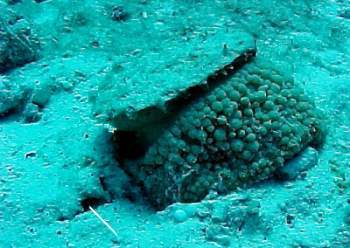
Hi,
Several years ago, in March, I discovered my first Umbraculum, under the Pier here on Bonaire, in the Netherlands Antilles, just north of Venezuela. I kept track of the critter until one day I found only its shell. I never saw another one - or thought to look for one, actually - until last month, when I found one on a night dive. Two days later I dived to find it, and found only the shell.
This time, though, it struck me that there might be more. Two days ago I found two individuals, about 15' apart: both were partly buried in sand, one up next to a rock and the other in the middle of a sand patch. This afternoon [4 April 2003] when I returned to try to photo them, I found the one in the sand patch easily, and began taking photos. Suddenly I noticed the second individual, just below the first but almost completely buried in the sand, front to front with the first. If this isn't a mating, it's just before or just after one, I think. The attached photos aren't the quality I'd hoped for, but I may have had better luck with film; I'll know tomorrow.
The eggs would be likely to be deposited under a rock ledge? A ribbon spiral about the same diameter as the parent? Do you think it's likely that their appearance is related to mating, or is it just coincidence I've only seen them during this time of year?
Thanks for any info you can give me on this fascinating creature.
Regards,
Dee Scarr
dee@touchthesea.com
Scarr, D., 2003 (Apr 7) Caribbean Umbraculum - mating. [Message in] Sea Slug Forum. Australian Museum, Sydney. Available from http://www.seaslugforum.net/find/9618Dear Dee,
Thanks for these interesting observations. I have put a pointer to what I guess is the gap between the shell and the body of the buried slug in both your photos. I don't think I have seen photos of Umbraculum mating so that's a first. As you will see in my earlier discussion of Ross Willis' photo of Umbraculum, this animal has its penis and female genital opening right at the front of the body below the head tentacles and above the mouth so I guess they can only mate by standing head to head. If you see them doing this again it would be of great interest to find out how they actually mate. We know very little about the biology of Umbraculum and there is some debate about whether the the structure I have identified in Ross Willis's photo is the actual penis or whether it is an external accessory flap. Pruvot-Fol (1960) has suggested that she thinks there is a penial papillae which is only visible when it is everted during copulation. It's probably not the easiest thing to do [or see] but if you do see a couple mating again perhaps you could gently pull them apart and see if the 'penis' is inserted in its partner or whether there is a thin white tube inserted instead.
Concerning the egg ribbon. There is a photo in Peggy Cable's message. It looks a bit 'limp' because it as out of water at low tide, but it gives you an idea of what the ribbon should look like. I don't know if their appearance is related to mating. Umbraculum lives for at least a year and I assume that it stays quite close to its food sponge most of the time. I guess it's possible they may go 'looking' for a partner away from their sponge when they reach sexual maturity, but as far as I know, their biology and natural history has never been studied in any detail.
Look at the other messages on this page and also have a look at the Umbraculum umbraculum. Although I have put your message on the Umbraculum mediterraneum page, as you will see in earlier discussions, it is probable that there is only one species of Umbraculum, and it has a worldwide distribution.
Best wishes
Bill Rudman
Umbraculum umbraculum? from Turkey
November 15, 2002
From: Haluk Akbatur
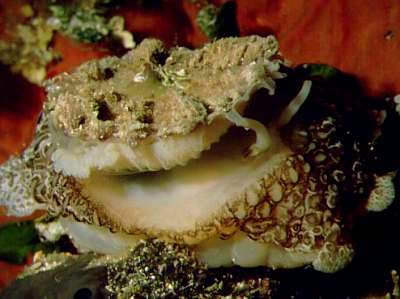

Dear Bill,
Could you confirm, please, the identification of this Umbraculum? I think it's Umbraculum umbraculum. What's the difference between it and U. mediterraneum.
Locality: Izmir-Çesme, divesite: Bedroom, Turkey. Depth: 38 m, 27 July 2002. Length: 4.5 cm
Thanks,
Haluk Akbatur
lasergoz@ttnet.net.tr
Akbatur, H., 2002 (Nov 15) Umbraculum umbraculum? from Turkey. [Message in] Sea Slug Forum. Australian Museum, Sydney. Available from http://www.seaslugforum.net/find/8411Dear Haluk,
Thanks for these photos of Umbraculum. With the shell lifted up, the large gill, which curves behind the head and down the right side between the shell and the body, is clearly visible. Concerning its identity. Have a look at my comments on the Fact Sheet for Umbraculum mediterraneum. Many names have been given to Umbraculum from around the world. At present we are down to about two names: U. mediterraneum for animals from the eastern, and probably western, Atlantic, and Umbraculum umbraculum for those from the Indo-West Pacific. There has been recent moves by shell collectors to consider there to be a single species worldwide, which would be Umbraculum umbraculum, but I feel that we should leave the two names in use until someone compares the anatomy of Atlantic and Indo-West Pacific animals. Lumping species together without evidence is no better than making new species with no evidence.
So my advice at present is that if it is from the Mediterranean region then you should call it U. mediterraneum until we get evidence to the contrary. In a recent message about an animal from the Caribbean, I noted that Atlantic animals seemed to have whitish radial marks on the edge of the tubercles, which were absent from Indo-West Pacific animals. I think your photos show this as well.
Best wishes,
Bill Rudman
Umbraculum f rom Florida
September 12, 2002
From: Maris Kazmers

This opisthobranch was photographed in Lake Worth Lagoon, a quasi-estuarine area just inside Lake Worth inlet along the east coast of Florida, USA.
Apparently it's a nocturnal feeder. The animal was seen twice during night dives (~20 foot depth), munching on sponge on one occasion [lower right photo]. During the day it was observed partially buried in the sand & shell rubble substrate. The photos were taken August, 2002.
Other photographers who frequently dive this well-defined site have not seen this species at this location before.
Maris Kazmers
sharksong@attbi.com

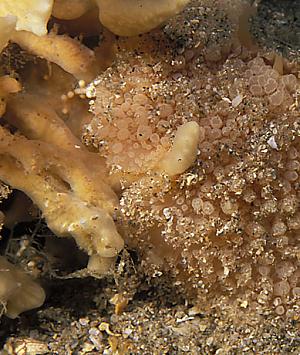

Dear Maris,
Thanks for these interesting photos. There are not many records of Umbraculum from anywhere in the tropical western Atlantic. Marcus & Marcus (1967) identified this species as Umbraculum plicatulum (Martens, 1881), but if there is a distinct species in the wstern Atlantic, then the earliest name would probably be Umbraculum bermudensis (Morch, 1875). As you will see in the Umbraculum mediterraneum Fact Sheet, there is no clear information on whether w should consider Umbraculum to be a single circumtropical species, or whether the Indo-West Pacific species U. umbraculum is distinct from the east Atlantic U. mediterraneum. And if they are different, is it possible that the west Atlantic species is U. mediterraneum or a third species? Clearly there needs to be some work done before a decision can be reached. Your photos are quite interesting as they clearly show that the tubercles have a pattern of radial or vertical wrinkles. This can also be seen in some Mark Thorpe & Katja Nagengast's photos of Umbraculum from the Canary Ids. I can't recall seeing similar wrinkles on Indo-West Pacific animals so it may suggest a distinction. This is pretty slender information for a definitive decision but certainly worth looking out for. I am putting your animals on the U. mediterraneum page, not because I am convinced there are distinct Atlantic and an IWP species but more to keep the question alive. I look forward to photos of other sea slugs from your area
Best wishes,
Bill Rudman
Umbraculum mediterraneum from France
July 29, 2002
From: Marina Poddubetskaia
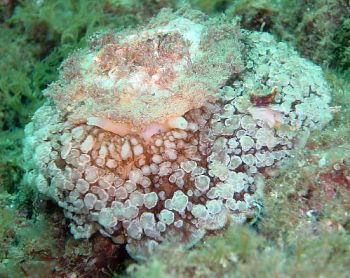
Dear Bill,
Here is a photo of Umbraculum umbraculum. Or maybe it is Umbraculum mediterraneum? I'm not sure which name to use.
Date: July 02, 2002, Cerbere, France [Memditerranean], Site: L'Ocell, Depth: 12m, Size: 12-13cm.
Photos: Marina Poddubetskaia - Nembro website
Best wishes,
Marina.
nembro@nembro.info
Poddubetskaia, M., 2002 (Jul 29) Umbraculum mediterraneum from France. [Message in] Sea Slug Forum. Australian Museum, Sydney. Available from http://www.seaslugforum.net/find/7548Dear Marina,
Thanks for the photo. Concerning the name. You will see this has been discussed in earlier messages. The general feeling is that there is probably only one species of Umbraculum worldwide. If that is so the earliest name is Umbraculum umbraculum. However it is possible that the east Atlantic form could be distinguished as Umbraculum mediterraneum but I am not sure where that leaves animals from the west Atlantic. Despite a general trend to synonymise U. mediterraneum with U. umbraculum, no one has examined the anatomy of these two species to see if this is justified. Until someone does, I feel we might as well continue to differentiate the Atlantic and Indo-West Pacific populations with separate names. See continuing discussion in messages on both species pages.
Best wishes,
Bill Rudman.
Umbraculum in Florida
June 1, 2002
From: Randy Jordan
I have collected an Umbraculum species here in Jupiter, Florida, USA. Is this species indigenous to these waters?
Randy Jordan
randy@jupiterdivecenter.com
Jordan, R., 2002 (Jun 1) Umbraculum in Florida. [Message in] Sea Slug Forum. Australian Museum, Sydney. Available from http://www.seaslugforum.net/find/7118Dear Randy,
If you have a look at the messages on the Umbraculum mediterraneum page you will see there is still no certainty on how many species there are in the genus. I have copied a list of names prepared by Guido T. Poppe, but 2 others are missing from this.
• Umbraculum pulchrum Lin Guangyu, 1981 from China
• Umbraculum bermudensis Moerch, 1875 from Bermuda.
The general feeling is that there is probably only one species, Umbraculum umbraculum, but that possibly the east Atlantic forms could be distinguished as Umbraculum mediterraneum. I am not sure where that leaves the west Atlantic ones. Unfortunately there is no simple answer.
Best wishes,
Bill Rudman
Re: Umbraculum - how many species?
February 19, 2000
From: Angel Valdés
Dear Bill,
There are few comments I would like to make about Poppe's list of species of Umbraculum.
Umbraculum bertinia, originally described as Bertinia bertinia Jousseaume, 1883 is actually a species of patellogastropod limpet, Cellana nigrolineata (Reeve, 1854). There is a paper by Kase & Valdés (1997) about this species.
I also have a paper in press dealing with some fossil material of Umbraculum and Spiricella (Valdés & Lozouet, in press). Spiricella unguiculus Rang & des Moulins, 1828 is not a species of Umbraculum. There are many differences in the shell of these two taxa. It is not clear whether it should be regarded as a member of the Umbraculoidea or not, until the soft parts of this animal become available.
In this paper we are also describing a new species of Umbraculum from the Upper Oligocene of France, which is also different from the Upper Eocene species Umbraculum laudunensis (Melleville, 1843). There are large differences in the protoconch of these fossil species.
There are more fossil species of Umbraculum described from North America and Australia, but I do not think anybody reviewed this material using modern taxonomic criteria.
It would not bother me at all if all the recent specific names of Umbraculum were synonymyzed.
Literature cited:
•Kase, T. & Valdés, A. 1997. The enigma of Bertinia bertinia Jousseaume, 1883 solved. Venus, 56: 233-240.
•Valdés, A. & Lozouet, P. [In press]. Opisthobranch molluscs from the tertiary of the Aquitaine basin (south-western France), with descriptions of seven new species and a new genus. Palaeontology.
avaldes@calacademy.org
Valdés, A., 2000 (Feb 19) Re: Umbraculum - how many species?. [Message in] Sea Slug Forum. Australian Museum, Sydney. Available from http://www.seaslugforum.net/find/1933Thanks Angel,
Bill Rudman.
Re: Umbraculum - how many species?
February 17, 2000
From: Erwin Koehler
Hi Bill,
The question is not one or two species, at Guido T. Poppe's site there are 10 species!
Erwin
Medslugs.Koehler@t-online.de
Erwin Koehler, E., 2000 (Feb 17) Re: Umbraculum - how many species?. [Message in] Sea Slug Forum. Australian Museum, Sydney. Available from http://www.seaslugforum.net/find/1922Dear Erwin,
The problem with lists, especially now with databases, is that they are too easy to prepare. Preparing a list of names from the literature does not mean they are valid or available. I have added Poppe's list below:
•Umbraculum bertinia F. P. Jousseaume, 1833 Japan
•Umbraculum chinesis Schumacher, 1817 Indo Pacific = sinicum
•Umbraculum mediterraneum J. B. Lamarck, 1819 Europe
•Umbraculum ovale P. P. Carpenter, 1856 West America
•Umbraculum plicatulum E. Von Martens, 1881 East America
•Umbraculum rushii W. H. Dall, 1889 America
•Umbraculum sinicum J. F. Gmelin, 1791 Indo Pacific
•Umbraculum umbraculum Lightfoot, 1786 Indo Pacific
•Umbraculum umbrella Martyn, Japan
•Umbraculum unguiculus Rang, 1827 Europe
All except the last one are either accepted synonyms of U. umbraculum or U. mediterraneum depending on whether they are from the Indo-West Pacific or the Atlantic.
Umbraculum unguiculus is based on - one fossil shell from Miocene of France. A Recent shell has been reported from Portugal (Hoeksema & Janssen (1984) Basteria, 48: 7-11) but there is no way of knowing if the fossil and the recent shell are the same. It was originally described as Spiricella unguiculus and there is no way of knowing if it is an Umbraculum.
One name missing from the list is
Umbraculum pulchrum Lin Guangyu, 1981 (Oceanologia & Limnologia Sinica, 12(3):286-290. There is no anatomical detail in the description to separate it from U. umbraculum.
So I am afraid I can't say how many species there are but I'm pretty sure there are no more than two. One lesson from the exercise is to realise that lists are meaningless unless they are attached to some information.
Cheers,
Bill Rudman.
Umbraculum - one or two species?
February 16, 2000
From: Erwin Koehler
Dear Bill,
Some days ago I renamed my U. mediterraneum from the Canary Islands into U. umbraculum because I thought there is only one species in the genus Umbraculum. Actually only U. umbraculum is listed to live in the Medterranean, and Peter Wirtz IDed his photos in older books as U. mediterraneum, but in his recent publication he uses U. umbraculum.
Erwin
Medlugs.Koehler@t-online.de
Koehler, E., 2000 (Feb 16) Umbraculum - one or two species?. [Message in] Sea Slug Forum. Australian Museum, Sydney. Available from http://www.seaslugforum.net/find/1898Dear Erwin,
I can't see any external difference between Umbraculum umbraculum and Umbraculum mediterraneum but without some anatomical evidence it really doesn't get us further ahead by saying they must be the same. In fact I find the act of synonymising two species together is more exacting than describing a new species.
I am just not aware of any recent anatomical comparison of the two species. If someone can let me know of one I would be most grateful. Otherwise I will err on the side of caution.
best wishes,
Bill Rudman.
Umbraculum mediterraneum from Canary Ids
February 13, 2000
From: M.Thorpe & K. Nagengast


Hi there,
Bumped into your site as I am looking for the common name for the Umbraculum mediterraneum. I noticed that you also requested a photo of one. I work as an Underwater videographer along with my girlfriend. We live in the Canary Islands and have just finished our latest film for El Hierro, the smallest in our small chain of volcanic Islands. We filmed one of these slugs during a night dive and the results are great. Our camera equipment is digital and we are able to take pics from the film via our computer. If you would like some clear pictures that could enhance your site let me know. We do not want payment as we wholeheartedly support biological research especially underwater biological research. All we would require is a note of recognition as an up and coming underwater camera team.
Sincerely,
Mark Thorpe & Katja Nagengast,
OCEAN-EYE VIDEO.
ocean-eye-video@tenerife1.com
Thorpe, M. & Nagengast, K., 2000 (Feb 13) Umbraculum mediterraneum from Canary Ids. [Message in] Sea Slug Forum. Australian Museum, Sydney. Available from http://www.seaslugforum.net/find/1888Dear Mark & Katja,
Thanks very much for the very welcome photos. I must say it looks very like the Indo-West Pacific species Umbraculum umbraculum. Good luck with your underwater camera business. I am more than happy to mention your activities any time you send us some opisthobranch photos.
You mention that you were looking for a common name for Umbraculum and note you used "Warty Sea Slug". Common names are a bit of a problem as they can apply to many quite unrelated species. I have seen Archidoris wellingtonensis called "Warty Sea Slug" and I am sure other species have also ended up with this rather unattractive name. If you must use a common name, one that has been used for Umbraculum umbraculum is the "Umbrella Slug" which refers to its umbrella-shaped shell.
best wishes,
Bill Rudman.
I need help with Umbraculum mediterraneum
January 14, 1999
From: Roberto Moresco
Dear Dr. Bill Rudman,
We find a in Mediterranean Sea the opistobranch Umbraculum mediterraneum. It has made egg mass that we are studying every day on microscope for understanding its development. Is there anyone who knows some information abaut Umbraculum.
many thanks!
Roberto
Moresco@freeweb.amicus.it
Moresco, R., 1999 (Jan 14) I need help with Umbraculum mediterraneum. [Message in] Sea Slug Forum. Australian Museum, Sydney. Available from http://www.seaslugforum.net/find/467Dear Roberto,
I have had a quick look and can't find any information on its biology. Hopefully someone can help us with information or a reference.
Bill Rudman.
